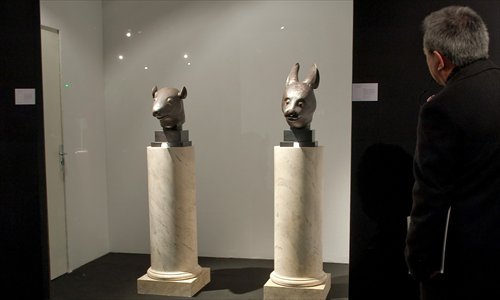French art expert battles to bring looted relics back to China

Bernard Gomez. Photo: CFP

The Chinese bronze sculptures of rat and rabbit head on display in Paris in 2009. Photo: CFP
On Monday, French art collector Christian Deydier, during his visit to China, returned to the country 24 gold ornaments from his personal collection, which were stolen from a 2,000-year-old tomb in Gansu Province. The move comes just two months after Deydier and French billionaire François Pinault returned 32 similar relics to China.
While the Chinese media has put the spotlight on Deydier and his donations, not many people know that the fight to bring back the items began over nine years ago, when he was sued by one of his compatriots for buying the gold ornaments stolen from China.
That compatriot was Bernard Gomez, a French art dealer and expert on Asian art, who has devoted much of his time over the past decade to tracking, stopping the sales and fighting for the restitution of stolen or looted Chinese artifacts in Europe. These efforts include intervening in the auction in 2009 of two Chinese bronze fountainheads looted during the sack of the Summer Palace in 1860.
In 2006, in a controversy that rocked the antique world of Paris, Gomez filed a lawsuit against Deydier, Museum Guimet and France's Ministry of Culture for the "concealment and laundering of artwork from international traffic of goods," helped by Gansu Province which provided evidence that the ornaments actually came from the looted ancient tomb.
While the courts dismissed the case citing the lack of evidence that Deydier had acquired the objects illegally, the case brought attention to the situation of Chinese relics lost overseas, and played an important role in the final restitution of the objects almost 10 years later.
Art crusader
While many questioned his motivation in suing his own government on behalf of another country, Gomez said he did so purely out of his love for Chinese art. "I got moral support from the public but never any financial support or sponsorship from anyone else," he said.
Gomez's passion for Chinese art and culture was sparked after his first visit to China in 1982. Since then, he has visited the country many times each year, traveling to its archaeological sites and working with Chinese archaeologists, who taught him a great deal and raised his awareness of Chinese relics lost overseas.
During his trips, he noticed that many Chinese archaeological sites had been badly damaged or looted, and the relics that should have been inside them were gone.
In 2004, after seeing many of these Chinese relics sold in auctions abroad, he set up the Association for the Protection of Chinese Art in Europe (APACE) to help retrieve the artifacts lost overseas, and was mandated by provincial governments, including those of Shaanxi and Gansu, to protect Chinese art on the world market.
The road to repatriating Chinese relics was a long and lonely one, Gomez said, and many of his efforts turned out to be fruitless.
In 2009, when two bronze fountainheads looted from the Old Summer Palace during the Second Opium War in 1860 were auctioned by the international auction house Christie's, Gomez protested the move and hired lawyers to press charges against it.
The judge later ruled against Gomez and his organization, ordering it to pay $1,000 in fines to the auction house and to the seller. However, the auction still failed after the successful bidder, Cai Mingchao, refused to pay the 28 million euros on moral and patriotic grounds.
In 2012, Artcurial, an auction house in Paris, put up another auction for an imperial jade seal from the Qing Dynasty (1644-1911). Gomez requested it be withdrawn, quoting Chinese officials who said the piece had been looted from Beijing's Old Summer Palace in 1860 when British and French troops invaded the city. The auction house ignored the request, denying the seal's origins and accusing Gomez's organization of orchestrating "a vast campaign of misinformation and maneuvers."
While his years of efforts won him moral support from Chinese officials and the Chinese public, they also brought him problems in his home country.
Gomez said he has been slandered and even threatened in France, and his business was severely affected as a result of his activism in the protection of China's historical objects in Europe. "I have been threatened by a lot of pressure on the art market which I had been very active in, and I still suffer the consequences today. But my conviction to protect Chinese heritage is stronger than my fear of being penalized," he told the Global Times.
He says that the opposition to his activities was so intense that he had to move to Spain, where he now spends most of his time.
Money on the line
Apart from legal methods, Gomez also used his personal savings and connections to help repatriate overseas artifacts.
In 2004, when he assisted in the authentication of ancient bronze wares, he noticed a bronze ding, or three-legged tripod, and immediately recognized it as a valuable artifact. The ding, about 17.5 cm high and 24.5 cm in diameter, had 50 characters inscribed on it, indicating the dynasties or states that had collected it in ancient China.
Later research showed that the ding was over 2,000 years old and dated back to the Han state in the Warring States Period (475-221 BC).
Gomez then talked to the owner of the ding and successfully persuaded him to sell it so that he could help repatriate it to China. Together with his friend, a Chinese businesswoman in Shaanxi Province, they bought the ding and presented it to the Shaanxi Provincial Cultural Heritage Bureau in 2006.
Gomez said that as local governments and relics departments usually have scant funds, they should seek the assistance of businesses to help return the artifacts, he told the media at that time.
Newspaper headline: The restitution man